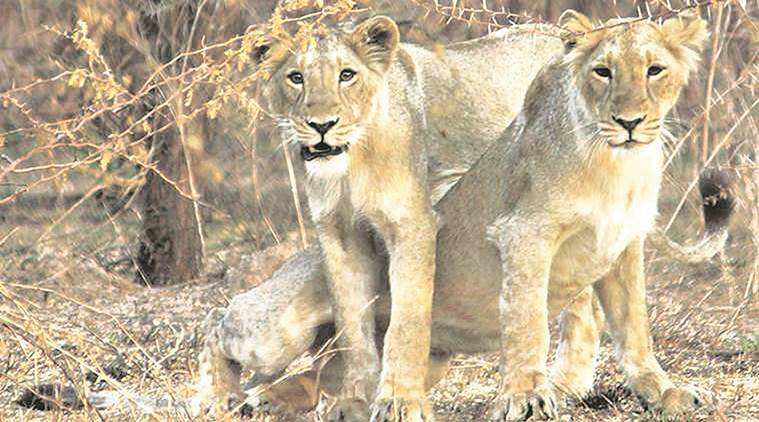 Asiatic lions, an endangered species which is surviving in the Gir forest and other protected areas. (File photo)
Asiatic lions, an endangered species which is surviving in the Gir forest and other protected areas. (File photo)Extremely heavy rain on July 14, 15 and 16 caused extensive damage to human life and property, but wild animals inhabiting Gir forest and other protected areas in the four districts were safe, forest officers said.
Written by Gopal B Kateshiya
| Rajkot |
Published: July 19, 2018 9:16:31 am
Three years after flash floods in Amreli and Bhavnagar districts left
11 Asiatic lions and 1,100 blue bulls dead, the twin districts and
neighbouring Gir Somnath and Junagadh are flooded again following very
heavy rain. This time, though, no death of any wild animal has been
reported. Officers cited the undulating topography and pattern of rain
as reasons for this.Extremely heavy rain on July 14, 15 and 16 caused extensive damage to human life and property, but wild animals inhabiting Gir forest and other protected areas in the four districts were safe, forest officers said.
Gir Gadhda, Una and Kodinar talukas of Gir Somnath are parts of Gir (West) forest division, while Khambha taluka of Amreli district is home to Gir (East) forest. Jafrabad and Rajula talukas, which are part of Amreli social forestry division, are important lion habitats. Similarly, Jesar, Mahuva, Palitana and Talaja taluka of downstream Bhavnagar districts are also part of the lion landscape and have protected forest areas.
“There are no reports of damage to wildlife or any wild animals being stranded in floodwaters. Gir terrain has some undulations. We are seeing flash floods in revenue areas because water runs off from hills to plains. But the forest has hillocks and wild animals instinctively move to higher places in such a situation,” Dheeraj Mittal, Deputy Conservator of Forests of Gir (West), told The Indian Express on Wednesday.
He said that trekkers were keeping track of Asiatic lions, an endangered species whose only wild population in the world is surviving in the Gir forest and other protected areas. “Some forest roads have been damaged due to heavy rain and low-floor vehicles are unable to move. Our staff are using motorcycles and utility vehicles for routine patrolling,” he said.
After heavy rain on July 12 and 13, Una received extremely heavy rain on July 14, recording 6 inches in 24 hours. A day later, the taluka was flooded as a cloudburst-like phenomenon triggered 18 inches of rain on July 16, cutting off rail and road traffic, snapping power lines and necessitating evacuation of hundreds of people. The next day the taluka recorded 5 inches of rain. In all, Una received 42 inches of rain in a week.
Neighbouring Gir Gadhda and Kodinar talukas were worse off. Gadhda was pounded by 20 inches of rain on July 16 alone, and 45 inches in seven days. The deluge affected coastal Jafrabad and Rajula talukas.
Torrential rain of 12 inches hit Jafrabad on July 16 while Rajula was hit by 7 inches, killing two people. Mahuva and Talaja of Bhavnagar also recorded 7 inches each, killing three people. The rains in Bhavnagar also left 19 cattle dead.
“Since the forest is hilly, lions and other animals seek refuge on hillocks. However, lions can become weak if continued rain prevents them from hunting. But no such weak big cat has been spotted yet,” said a field forest officer of Gir (West). Another officer said that the thick vegetation in Gir forest prevented flash floods.
Also, this year, the rainfall has been concentrated in hilly parts of forest and revenue areas, mostly along the coast. “It has been raining very heavily for a week. But animals have apparently moved to higher reaches instinctively. We have not had to undertake any operation to rescue any wild animal,” said Rajal Pathak, range forest officer of Rajula.
The lion census conducted in May 2014 pegged the number of Asiatic lions at 523. Of them, 174 were spotted in Amreli district alone and 37 in Bhavnagar. Junagadh had recorded 268 big cats while Gir Somnath had 44.
Sandeep Kumar, Deputy Conservator of Forests of Bhavnagar, said the situation was manageable. “The terrain in Mahuva, Palitana, Jesor etc is slightly undulating, so animals could move to safer places,” he said.
In June 2015, 11 lions, 1,100 blue bulls and some other wild animals were killed after a cloudburst caused a flash flood in Amreli. The carnivores, which forest officers said were ranging in Rajula in Gir (East) forest and Liliya, Krakach and other areas of Amreli social forestry division, were swept away by the swollen Shentrunji river.
https://indianexpress.com/article/cities/ahmedabad/lions-in-gir-safe-as-they-seek-refuge-from-rain-on-hillocks-say-forest-officers-5265552/
No comments:
Post a Comment